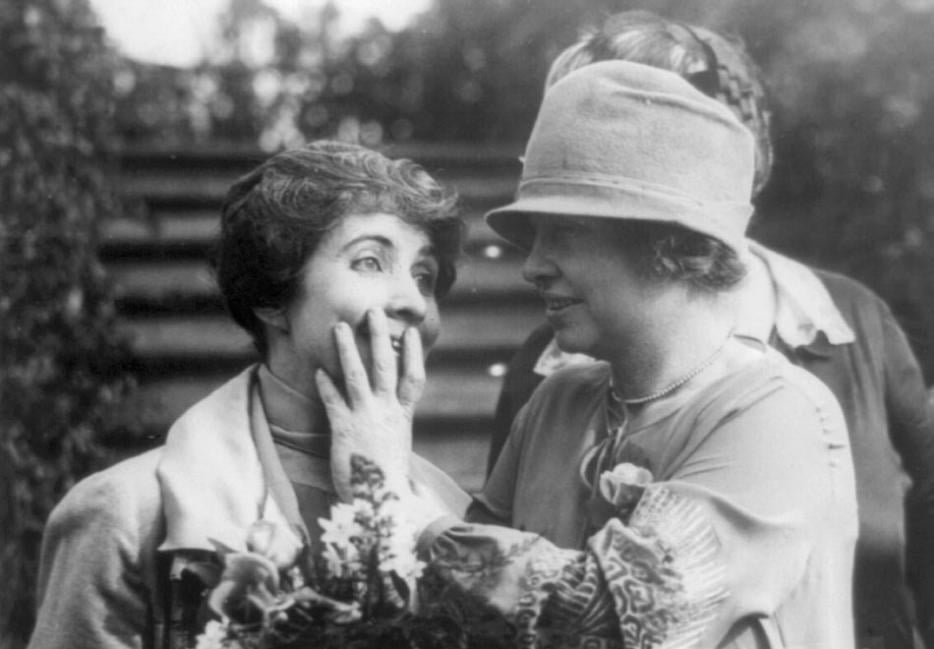Helen Keller was beautiful. I don’t mean that she had a beautiful soul; I mean that she was, by conventional standards, a total babe. She had “regular, almost perfect features and blue eyes that were the colour of the sky on a perfectly clear day... Her porcelain complexion was clear and smooth, and she had a luxuriant mane of chestnut hair that cascaded down her back.” Moreover, added Dorothy Herrmann, who wrote this description in 1998, “Her figure was voluptuous; she had large breasts, small hips, and lovely, shapely legs.”
People felt awkward talking about the sex appeal of someone whose mental and spiritual presence among them was seen as a miracle. Herrmann quotes a man who commented on how “fully developed” Keller was at 14, and then hastened to say that, “she had come straight from the hands of God, and for 14 years the world and the flesh and the devil had not obtained possession of her.”
The flesh, of course, already had possession of Helen Keller, as it does of us all. Correspondences, the collaboration between poet Anne Michaels and visual artist Bernice Eisenstein, features a portrait of Keller in her middle years. In Eisenstein’s depiction, Keller’s face is wide at the cheekbones and tapers to a delicate chin and full mouth. Her hair is in soft bluish waves, and her eyebrows are handsome. Her eyes have heavy white lids, and the irises underneath are white as pebbles on a creek bed. The portrait is accompanied by a few words from the poems “Homecoming” and “Flower” by Paul Celan: “Below, hidden,/ presses up.../ There: a feeling./ Your eye and mine:/ they see/ to water.” “Water” was famously the first word that Keller understood, as her teacher, Anne Sullivan, finger-spelled it into one of Keller’s hands while pumping well water over the other.
A person is more than the shape of her eyebrows or the set of his mouth, but we are used to being allowed to forget that we know this—for social convenience, we tend to conflate looking at a person’s face with looking at a person. We expect someone we’re looking at to adjust their expressions for our eyes, exaggerating or minimizing their feelings to keep inner and outer life in socially acceptable balance. All faces are lies, but the faces of the blind, in which the face’s owner can only guess at what it looks like, enact a dramatic irony so total we can’t be sure which side of the curtain we’re on.
People who met Keller were struck by her unpredictable expressions—where most of us adjust our facial expressions by mirroring the faces of others, Keller’s face was alternately stony and inexplicably animated. In 1907, Susan Coolidge wrote of Helen Keller: “Like a strange alabaster mask her face,/ Rayless and sightless, set in patience dumb,/ until like quick electric currents come/ The signals of life into her lonely place.” In 1912, the singer and actress Georgette Leblanc wrote: “In a drawing-room of visitors, in a volatile atmosphere of glances, smiles and chatters, Helen, quivering as the forest quivers in the night wind, changeful, impetuous, eloquent as nature itself, or suddenly terrifying in her adamantine immobility[.]”
Paradoxically, portraits of blind subjects can help us to understand the difference between what we perceive and what is there. In Julia Fullerton-Batten’s 2013 series “Blind,” the photographer asks her subjects to choose where they would like to be photographed and then write about their choices using voice recognition software and a Braille keyboard. A young woman named Joy stands in front of a bus stop, her hands laid gently on her chest as if to say, “Who, me?” She wrote:
The reason I was photographed outside a bus stop was because I have been using that same bus stop for a number of years now. I have been taking very similar routes which mostly consisted using this particular bus journey. I have now moved out of the family home and therefore will not be using the bus stop as often, however it is a route that I will never forget.
When I look at the bus stop, I see a black metal structure with glass panes; the glass is so dirty that at first glance it looks like a shabby white wall. Behind the bus stop is a wet road, and on the other side a bare tree stands in the green lawn of a public park. I can see Joy seeing the bus stop in her mind’s eye, and I know that what’s meaningful to me—the dirtiness of the glass, the brightness of the grass—is not what the bus stop looks like to Joy. In the same way, looking at Joy—her smooth, calm face, the blue dyed streaks in her hair—I’m reminded that what I see is not what she knows of herself.
Helen Keller’s fetching sky-blue eyes were glass. She had them put in as an adult, after her own blind eyes were surgically removed. The left had protruded slightly, and before the surgery she was always photographed in profile so as to hide the disruption to her beauty. In a black and white photo from 1945, taken in the studio of artist Jo Davidson, Keller’s left side is turned towards us. She is feeling a portrait of herself—a sculpture that Davidson made. Her right hand is on her cheek, her left grazes her collarbone. Davidson, a kind-looking man with a bushy beard, stands between the clay-Keller and the flesh—between the face that is and the face as we see it.
Every week, Linda Besner reads a new book and writes on a tangentially related topic.





